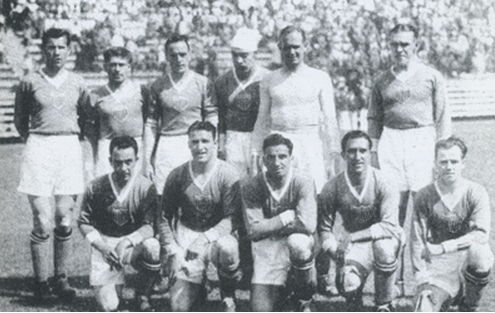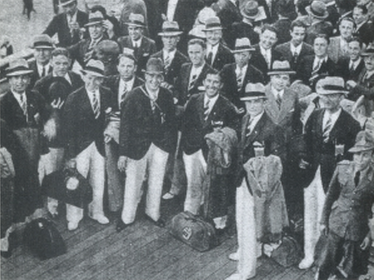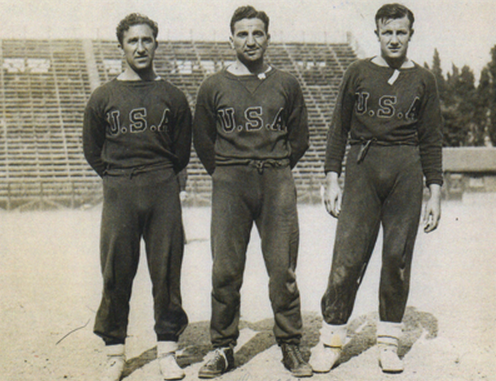
While the last time the U.S. faced an opponent in a one-off playoff match was the 3-0 loss to Canada on December 22, 1976 at Estadío Sylvio Cator in Port-au-Prince in Haiti, the first time was against Mexico to qualify for the 1934 World Cup.
The 1934 US World Cup team
The management of the 1934 U.S. World Cup team was distinctly Philadelphian. Team manager Elmer Schroeder, who also happened to be the president of the U.S.F.A., had been born in the city and played soccer at the University of Pennsylvania when Penn was the national collegiate champion in 1919 and 1920. After managing the U.S. team at the 1928 Olympics, Schroeder managed the Philadelphia German Americans team that won the National Amateur Cup in 1933 and 1934. He chose as the 1934 U.S. World Cup team’s coach David Gould, the Scottish immigrant who settled in Philadelphia decades before and played on the John A. Manz team that won the American Cup in 1897. Gould later was an assistant coach at the University of Pennsylvania when Schroeder was a student there. The team’s trainer, Raymond Gadsby, was also from Philadelphia.
The 1934 U.S. World Cup squad was selected through a series of three tryout matches, with the first and third matches taking place in Philadelphia. In the first match on May 2, 1934, the U.S. team beat the Pennsylvania League All-Stars, 8-0. Two days later in Newark, New Jersey, the U.S. side lost 4-0 to an A.S.L. all-star team that included the legendary Archie Stark, who had not been selected for the U.S. team and scored a hat trick in the game. In the final match on May 5, the U.S. beat the Eastern Pennsylvania All-Stars, 2-0.
Performance in the series of tryout games wasn’t the only factor involved in player selection. As part of its selection process, the U.S.F.A.’s Foreign Relations Committee, which had been tasked with assembling the squad, sought to recognize the finalists of the 1934 National Challenge Cup by including as many players as possible from the Pawtucket Rangers and Stix, Baer & Fuller. But a significant consideration was money. As Newark Star-Ledger reporter Tom Connell wrote of the absence of any players from northern New Jersey, a longtime hotbed of U.S. soccer talent, the selection committee “admittedly worked on the principle that sections could not be considered that did not help defray the expenses incidental to the trip, and which would not pay the expenses of their candidates for places. It was this that probably accounts for the fact that New Jersey was passed up in the selections. This state did not raise as much revenue for the trip as other districts.”
It was, as Connell explained, a “compromise” team.
The squad of nineteen players included six players from Pennsylvania teams. Five came from the Philadelphia German Americans, including Peter Pietras, William Fiedler, Albert Harker, Herman Rapp and the captain of the team, Francis “Hun” Ryan, who had also played on the 1928 Olympic team. Only Pietras and Ryan would appear in the 1934 World Cup.
The sixth player, Aldo “Buff” Donelli, had been born in Morgan, a town in western Pennsylvania not far from Pittsburgh. While attending Duquesne University, Donelli played for the school’s American football team on Saturdays and in amateur soccer leagues on Sundays. In 1929, the 5ft 7in, 170lb center forward was on the Heidelberg FC team that won the National Amateur Cup, scoring five goals in the 9-0 win over the First Germans of Newark. Donelli was playing for the Curry Silver Tops in Pittsburgh when he received an invitation to tryout for the U.S. team. He scored a hat trick in the first tryout game, the 8-0 win over the Pennsylvania League All-Stars.
Also on the 1934 squad were veterans of the 1930 team including Jimmy Gallagher (Cleveland Slavia), who had played for Philadelphia’s Fleisher Yarn in 1924-25, Thomas Florie (Pawtucket Rangers), and George Moorehouse and Billy Gonsalves (St. Louis Stix, Baer & Fuller). Two other players came from St. Louis Stix, Baer & Fuller (winners of the US Challenge Cup in 1933, 1934, and again in 1935), three more from Pawtucket Rangers (runners up in 1934), and one each from the Chicago Wieboldt Wonder Bolts, Baltimore Canton, Brooklyn Celtic, and the New York Americans.
The lead up to the 1934 World Cup

Just as the game of soccer had been hard hit by the Depression, so too had the United States Football Association. Because of its uncertain financial status, the U.S.F.A. was late in submitting its application to compete in the 1934 World Cup. FIFA accepted the application with the stipulation that the US would have to play a one-off qualification game against the winner of the North American qualifying round of games, Mexico, who had defeated Cuba in three straight qualification games, outscoring their opponents 12 goals to 3. While Mexico had played only 14 official and unofficial international matches at this point, the U.S. itself had played only 15 since its first official international in 1916 with none played from 1931 through 1933.
Departing on the Italian Line steamship Roma on May 5, 1934, the U.S. party of 19 players and coaches arrived in Rome on May 14. The next day, the team had its first training session at Roma’s training ground — playing baseball. They played soccer for the first time since leaving the U.S. the following day. Donelli remembers in Tony Cirino’s U.S. Soccer vs The World “that there was no effort to get to know one another’s playing styles.” Donnelli relates the training consisted of
just practicing movements up in front like passing for forwards and crossovers from the outside men. It is not a real big practice because there is no defense moving and you don’t know where the heck to move and in those days we did not move like they do now. You played center forward, you would be a center forward. You had to make your opening from the defense as you could and you did not stay too far away from that one position.
Donelli started the team’s first scrimmage game in Rome on the reserves side. At the half, the reserves, filled out with three Roma players, were leading the first team, 1-0, thanks to goal from Donelli. In the second half, Donelli was moved to the first team and ended up scoring the winning goal.
Donelli’s playing style was notable for the time. Cirino describes, “Habitually he ran all along the front of the attack, moving to the right and left and dropping back. His style was unusual for a center forward, who, according to the 2-3-5 of the period, should station himself permanently in the penalty area.”
Nevertheless, Donelli was unknown to the professional players on the team and he had the impression they were “disdainful of the amateur from the coal fields.” He said later, “There was a clique among the New York and St. Louis players and they wanted to keep me out of the lineup.” Recognizing Donelli’s undeniable talent for goals, Billy Gonsalves, the “Babe Ruth of American Soccer,” who described the center forward as being like “a little truck,” told Schroeder he wouldn’t play if Donelli wasn’t on the starting roster against Mexico.
Qualification game against Mexico
After receiving a special audience with Pope Pius XI on May 23, the U.S. met Mexico in Rome on May 24 at the Stadio Nazionale del Partito Nazionale Fascista (National Stadium of the Fascist Party) for the qualifying match in front of a crowd of 10,000 that included Italian dictator Benito Mussolini and the American ambassador, Breckinridge Long. Donelli scored the first goal at the fifteen minute mark, receiving a long pass from right back Edward Czerkiewicz after he had intercepted the ball. Cirino describes Donelli’s breakaway: “He avoided one opponent, another one fell as he ran after him, and Donelli had no problem beating the goalie: 1-0.”

Seven minutes later, Manuel Alonso equalized for Mexico, but the scoreline would not remain level for long. In the 32nd minute, left wing William McClean connected with Donelli, who fired a low shot to put the U.S. up 2-1.
Fourteen minutes into the second half Mexico’s Lorenzo Camarena was ejected for trying to pull Donelli down as he advanced on goal. Now with a one-man advantage, the U.S. and Donelli pressed for control of the match. In the 74th minute Donelli received a pass from inside right Werner Nilsen and broke away from the two defenders marking him before firing a blast on the run that froze Mexico goalkeeper Rafael Navarro to make the score 3-1. While Dionisio Mejía scored for Mexico to make it 3-2 a minute later, Donelli added to his hat trick in the 87th minute with a surprise shot between two defenders and the match ended with the U.S. winning, 4-2.
Donelli, who would have scored five goals in the game if he hadn’t missed a penalty kick, became the first U.S. player to score four goals in a World Cup qualifier. He is quoted by Cirino,
Mexico had a team that was pretty equal to ours. But they were not very quick. They had a very, very deliberate style of attack. There was not a whole lot of imagination; it was a predictable attack. And if you did anything. If you moved a wee bit, it would put them off balance. I was just able to go around the man very easily, and once I was around him…”
The New York Times said of the Mexico team in its report of the game on May 25, 1934 (which mistakenly attributes three of Donelli’s goals to Thomas Florie and one to Werner Nilsen), “The Mexican players appeared to be technically superior to the Americans, but they were all of much slighter build and were obliged to yield to the more vigorous game of their heavier opponents.”
That, and the “little truck.”
The U.S. would not defeat Mexico again for another 46 years, going winless for 26 games until the 2-1 victory in a World Cup Qualifying match on November 23, 1980 in Fort Lauderdale, Florida.
Three days after the playoff game against Mexico, the U.S. faced host country Italy on May 27 in the first round of the 1934 World Cup, which was being played in a straight knockout format for the first time (group play would return for the 1950 World Cup). Donelli scored the lone American goal in the 7-1 loss to the eventual champions. Despite receiving offers to play in Europe professionally, Donelli returned home with his team on June 24 after the US played a series of exhibition games — two in Italy and four in Germany for a 3-1-2 record — never again making an appearance for the national team before embarking on a long coaching career in college and professional American football. During the Second World War, he returned to soccer, playing with the Morgan Strasser team that reached the National Challenge Cup final in 1943 and 1944, losing each time to Brooklyn Hispano.

A great account of an interesting chapter in American soccer history. Donelli was a meteor: A short career, but brilliant while he lasted.
During the match against Mexico, U.S. wore blu-navy shirts but in the next game against Italy someone suggests it wore red ones not to clashing with pale-blue of Italy as reported here http://www.historicalkits.co.uk/. Is it true?
Pingback: The record-setting Archie Stark – Society for American Soccer History
Pingback: Week Six (: – Sports & the Making of the Americas
Pingback: USA vs Mexico Matchday Historical Preview
Pingback: La maravillosa historia que no conocías de los Estados Unidos
Pingback: The life — and murder — of the first American-born president of U.S. Soccer – Society for American Soccer History
Pingback: Howard’s heroics to dos a cero: US men’s World Cup campaigns ranked - Newsbrella - Curated News
Pingback: Howard’s heroics to dos a cero: US men’s World Cup campaigns ranked | USA - AYTECHJOB
Pingback: Howard’s heroics to dos a cero: US males’s World Cup campaigns ranked | USA - World news International News
Pingback: Howard’s heroics to ‘Dos a Cero’: US men’s World Cup campaigns ranked | USA – unuvi.com
Pingback: Howard’s heroics to ‘Dos a Cero’: US men’s World Cup campaigns ranked | USA - News Concerns
Pingback: Howard’s heroics to ‘Dos a Cero’: US men’s World Cup campaigns ranked | USA | Reported Crime
Pingback: Howard hőstettei a Dos a Cero-hoz: az Egyesült Államok férfi vb-kampányai rangsorolva | USA - The Guardian - news-portal.online
Pingback: Howard's Championships for "Dos a Cero": US Men's World Cup Campaigns Ranked | United States of America - NEWS BASKET
Pingback: Howard’s heroics to ‘Dos a Cero’: US men’s World Cup campaigns ranked | USA - swifttelecast
Pingback: Howard’s heroics to ‘Dos a Cero’: US men’s World Cup campaigns ranked | USA - Illuminati Press
Pingback: Howard’s heroics to ‘Dos a Cero’: US men’s World Cup campaigns ranked | USA - THE HERALD AFRICA
Pingback: Howard’s heroics to ‘Dos a Cero’: US men’s World Cup campaigns ranked | USA – Keluaran SGP, Togel Singapura, Data SGP, Pengeluaran SGP Hari Ini
Pingback: Howard’s Championships for “Dos a Cero”: US Men’s World Cup Campaigns Ranked | United States of America – comnavikyo